25 Wabi Sabi Kitchen Ideas for a Functional and Aesthetic Space
To create a Wabi Sabi kitchen, embrace natural materials like wood and stone, and opt for earthy color palettes that evoke tranquility. Incorporate handmade pottery and vintage kitchenware to celebrate imperfections.
Utilize reclaimed wood for shelving and combine old and new elements for character. Soft, flowing fabrics add warmth, while cozy nooks invite relaxation.
Don’t forget to showcase the beauty of wear and tear, adding depth to your space. Discover more ways to enhance your kitchen’s aesthetic.
1.Embrace Natural Materials

When you embrace natural materials in your kitchen, you’re not just enhancing the space’s aesthetic; you’re also creating a warm and inviting atmosphere that feels grounded and authentic. Think about incorporating elements like wood, stone, and clay.
A reclaimed wood island or butcher block countertops can serve as the heart of your kitchen, showcasing unique grains and textures that tell a story. Consider using stone tiles for backsplashes or flooring, offering durability and a timeless appeal.
Their cool, earthy touch contrasts beautifully with warm woods, enhancing the natural vibe. Don’t forget about clay or ceramic dishware; their organic forms add character and charm.
By choosing materials that reflect the beauty of nature, you create a cohesive space that invites connection—both with the environment and with those you gather around your table. Embracing natural materials is an essential step toward achieving the serene essence of Wabi Sabi in your kitchen.
2.Choose Earthy Color Palettes
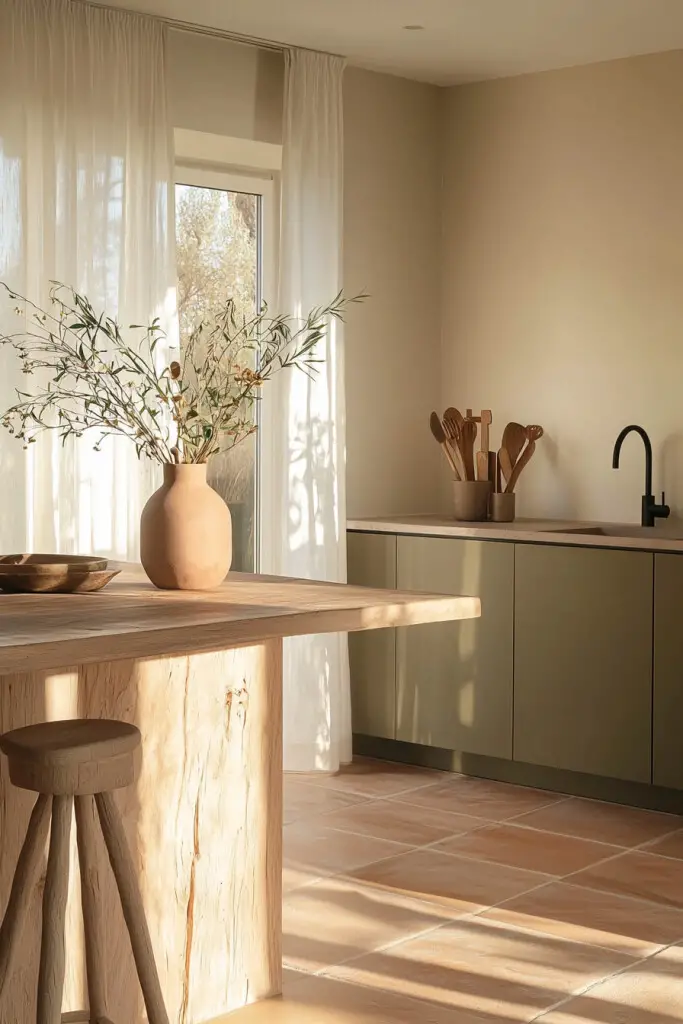
Choosing earthy color palettes can transform your kitchen into a tranquil haven, inviting warmth and grounding energy into the space. Opt for shades inspired by nature, like soft browns, muted greens, and gentle terracottas.
These colors not only create a calming atmosphere but also harmonize beautifully with natural materials, enhancing the wabi-sabi aesthetic. Imagine warm taupe cabinets paired with sage green walls, or a cinnamon-hued backsplash that echoes the richness of clay.
You’ll find that these tones evoke a sense of connection to the earth, promoting mindfulness in your cooking and gathering experiences. Don’t shy away from darker hues, either; deep charcoal or forest green can add depth and sophistication.
By layering these earthy tones, you can create a cozy, inviting space that feels both functional and aesthetic. Embrace the beauty of imperfection by allowing your color choices to reflect the organic, ever-changing nature of your kitchen.
3.Incorporate Handmade Pottery
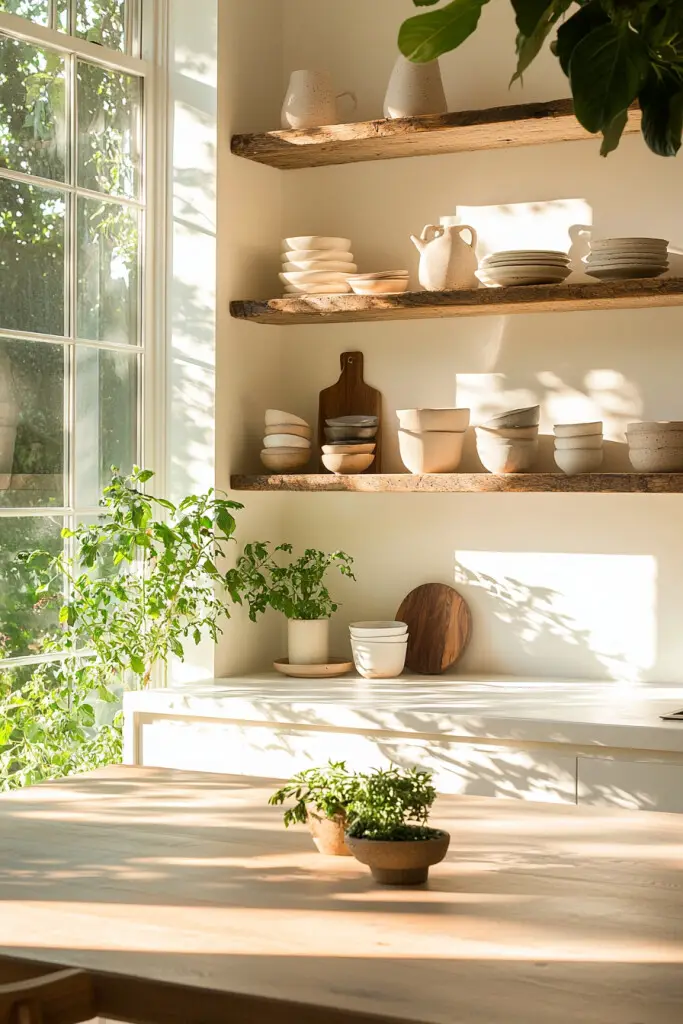
There’s something truly special about incorporating handmade pottery into your kitchen decor. Each piece tells a story, showcasing the unique craftsmanship and imperfections that embody the Wabi Sabi philosophy.
Consider using hand-thrown bowls for serving, textured mugs for your morning coffee, or artistic plates that add character to your dining experience. When you choose pottery in earthy tones, it harmonizes beautifully with the natural elements in your kitchen, enhancing the overall aesthetic.
Mixing and matching different styles not only creates visual interest but also reflects your personal taste. Don’t shy away from displaying these pieces; arrange them on open shelves or countertops to create an inviting atmosphere.
Handmade pottery serves a functional purpose while acting as a striking focal point. By making these unique items a part of your kitchen, you’ll embrace the beauty of imperfection and create a warm, welcoming space.
4.Use Reclaimed Wood for Shelving
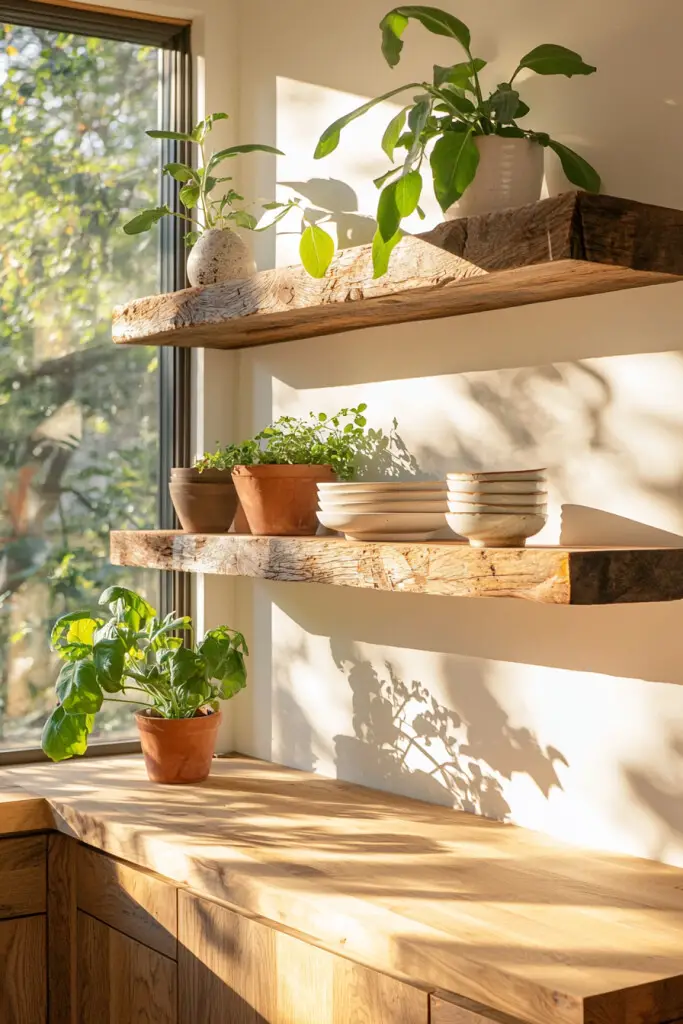
Embracing reclaimed wood for shelving not only adds rustic charm to your kitchen but also aligns beautifully with the Wabi Sabi aesthetic of celebrating nature’s imperfections. Each piece of reclaimed wood tells a story, showcasing unique textures and colors that can transform your space into a warm, inviting haven.
You can use old barn wood or salvaged beams, letting the natural wear and character shine through. When arranging your shelves, consider a mix of varying heights and depths to create visual interest.
Use these shelves to display artisanal pottery, cookbooks, or even small potted herbs, seamlessly blending functionality with beauty. The imperfections in the wood, like knots and scars, become focal points, reminding you of the beauty in life’s transience. Plus, using reclaimed materials is environmentally friendly, allowing you to contribute to sustainability while crafting a kitchen that reflects your personal style and values.
5.Opt for Vintage Kitchenware
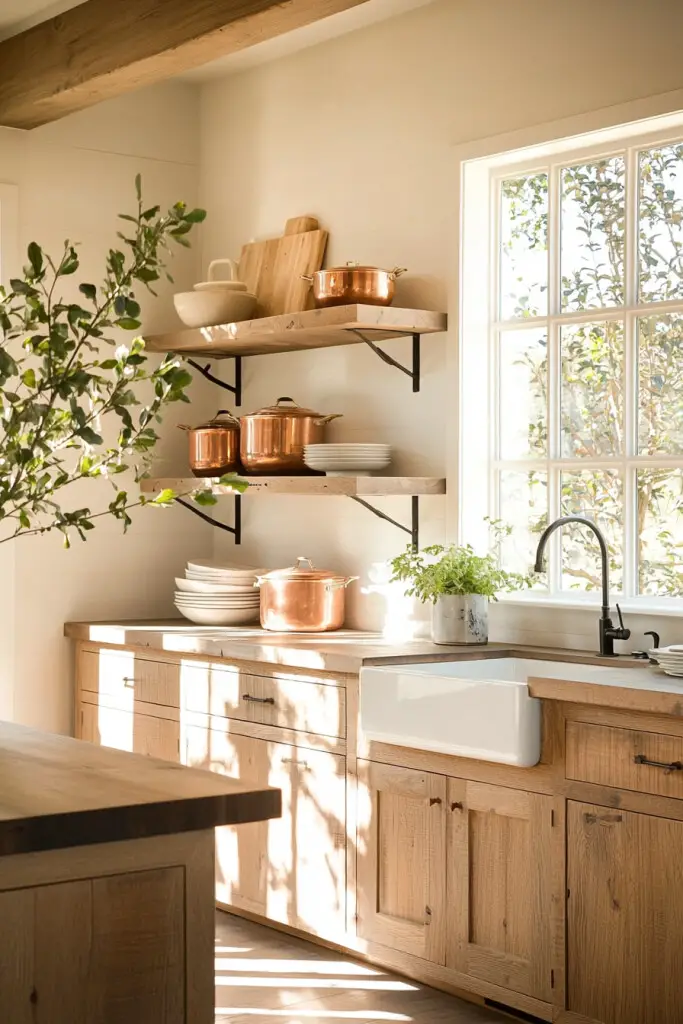
Incorporating vintage kitchenware into your space adds a layer of charm and character that modern pieces often lack. Imagine the warmth of a rustic ceramic bowl or the playful patterns of retro plates; these items tell stories that new kitchenware simply can’t.
When you opt for vintage, you’re not just decorating; you’re curating a collection filled with history and personality. Look for unique finds at thrift stores, flea markets, or family heirlooms.
Each piece—be it a well-loved teapot or a set of mismatched cups—invites conversation and nostalgia. You’ll appreciate the imperfections that come with age, which perfectly align with the wabi-sabi philosophy of embracing beauty in flaws.
Mixing these vintage treasures with contemporary elements creates a balanced aesthetic, making your kitchen feel warm and inviting. So go ahead, let your vintage kitchenware shine—they’re not just functional but also a reflection of your personal style.
6.Showcase Open Shelving
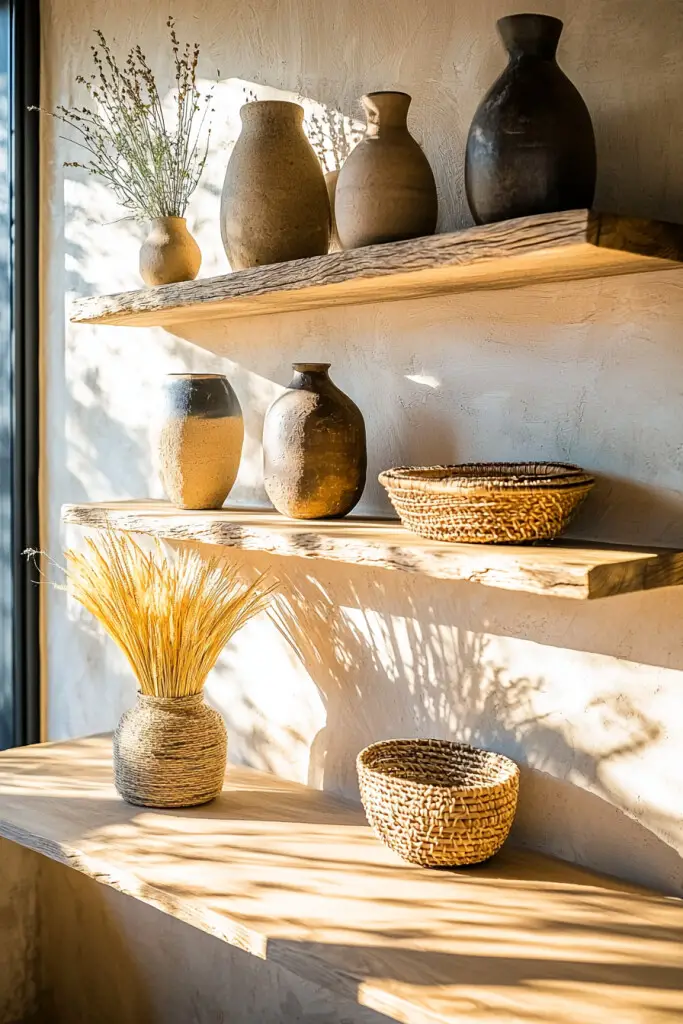
How can you transform your kitchen into a showcase of beauty and functionality? One fantastic way is by incorporating open shelving. This design choice not only enhances the aesthetic of your space but also invites a sense of warmth and accessibility.
Imagine displaying your favorite vintage dishes, unique jars, or handmade pottery on shelves that draw the eye upward, creating an open, airy feel. With open shelving, you can curate an ever-evolving gallery of your kitchen essentials.
You’ll find it encourages you to keep your items organized and encourages creativity in how you showcase them. Consider mixing materials—wood and metal can complement each other beautifully.
7.Include Organic Textures
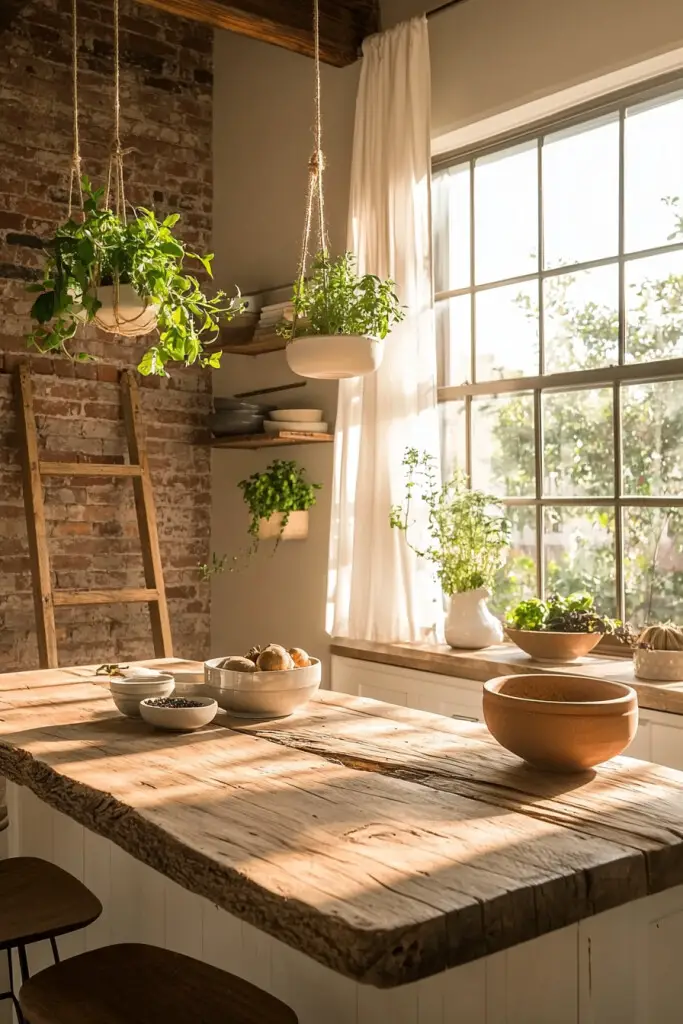
While you might think of sleek surfaces and polished finishes when designing a kitchen, including organic textures can truly elevate the space. Incorporating elements like rough-hewn wood, hand-thrown pottery, or stone accents can add warmth and personality.
Imagine a wooden countertop with visible grain, or shelves made from reclaimed wood, their imperfections telling a story. You might also consider incorporating textured wall finishes, such as plaster or natural paint, which can create depth and intrigue. Accessories like woven baskets or handmade ceramics not only serve a functional purpose but also enhance the organic feel of your kitchen.
8.Add Natural Fiber Rugs
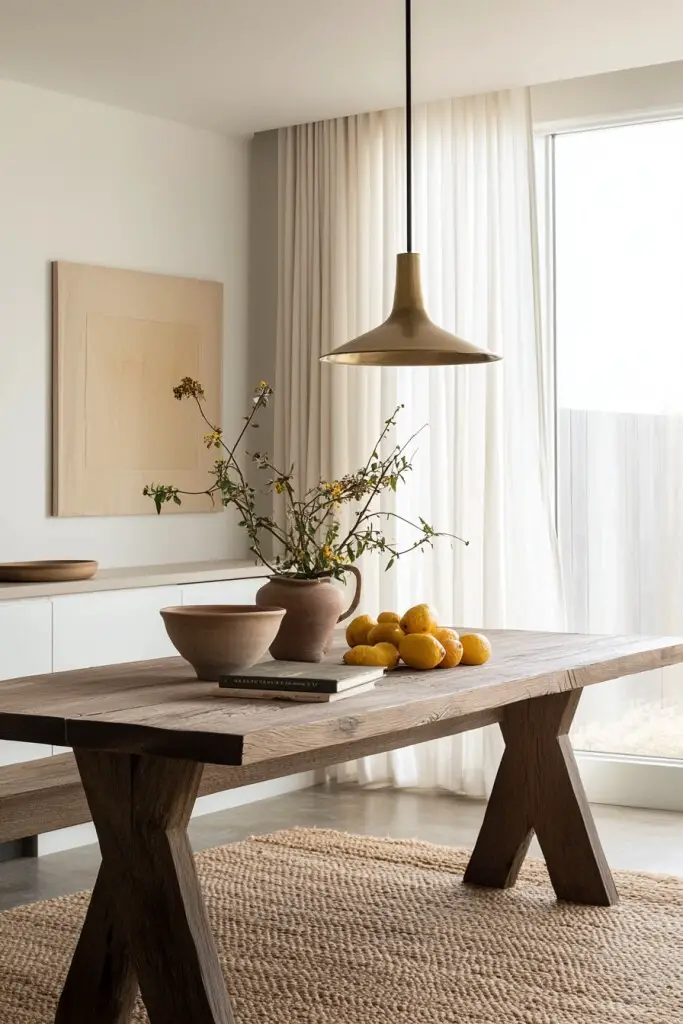
When you want to bring a sense of warmth and comfort into your kitchen, adding natural fiber rugs can make a significant difference. These rugs, crafted from materials like jute, sisal, or wool, not only enhance the aesthetic appeal but also create a cozy atmosphere.
Imagine stepping onto a soft, textured surface as you start your day; it instantly transforms the space. Natural fiber rugs are also incredibly durable, making them perfect for high-traffic areas like kitchens.
They can withstand spills and stains, and their earthy tones and organic textures align beautifully with the Wabi Sabi philosophy, celebrating imperfection and authenticity. Choosing a rug with a simple pattern or a neutral color palette allows it to blend effortlessly with your kitchen decor.
Plus, they’re easy to clean, ensuring your space remains inviting and functional. Embrace the beauty of natural fibers to elevate your kitchen’s overall ambiance.
9.Focus on Simple, Functional Design
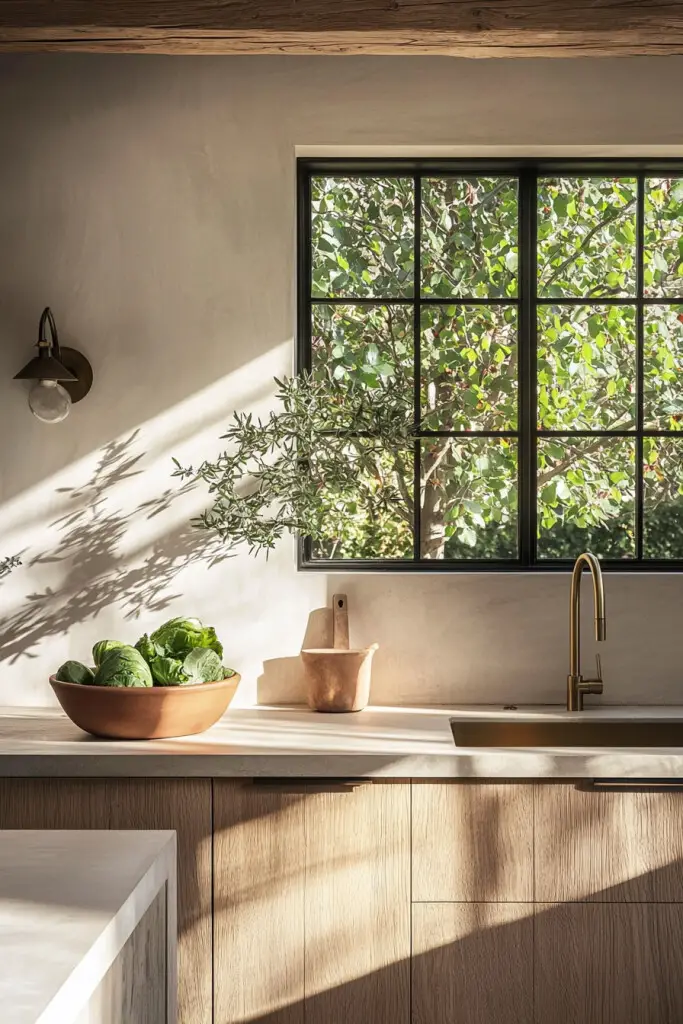
A simple, functional design can transform your kitchen into a serene haven, embodying the essence of Wabi Sabi. Start by decluttering your space; open countertops invite calmness and ease.
Choose cabinetry with clean lines and minimal hardware, allowing the beauty of natural materials to shine through without distraction. Opt for open shelving to display a few well-chosen items, ensuring everything has its place while maintaining an airy feel.
Incorporate multifunctional furniture, like a sturdy kitchen island that serves as both prep space and dining area, promoting practicality. Choose a muted color palette inspired by nature—think soft earth tones or gentle whites—to create a cohesive, soothing environment.
10.Highlight Imperfect Ceramics

Embracing the beauty of imperfect ceramics can add a unique charm to your Wabi Sabi kitchen, inviting character and warmth into the space. Think hand-thrown bowls with uneven rims or rustic mugs with subtle cracks; these pieces tell a story.
Instead of seeking perfection, celebrate the flaws that make each item one-of-a-kind. Display your ceramics on open shelves, allowing their textures and colors to shine.
Mix and match pieces for an eclectic look—an earthy glaze paired with a vibrant hue can create a beautiful contrast. Use these ceramics not just for decoration but also for everyday meals, turning each dining experience into a mindful moment.
Don’t shy away from showcasing repair techniques like kintsugi, where cracks are highlighted with gold, emphasizing resilience and beauty in brokenness. By incorporating these imperfect ceramics, you’ll cultivate a space that feels lived-in, authentic, and truly reflective of the Wabi Sabi philosophy.
11.Implement Soft, Ambient Lighting
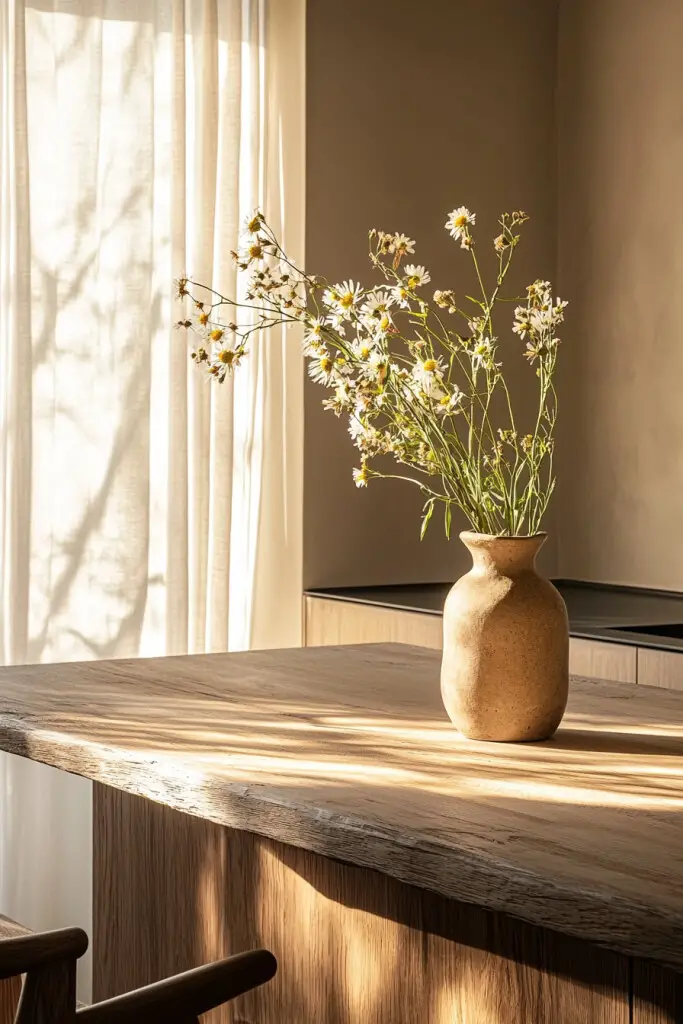
To create an inviting Wabi Sabi kitchen, implementing soft, ambient lighting is essential, as it transforms the atmosphere into a serene haven. Think about using warm, dimmable fixtures that allow you to customize the brightness for different times of day.
Pendant lights with a rustic finish or vintage-inspired bulbs can enhance the organic feel of your space, complementing the raw textures of your materials. Consider layering your lighting with wall sconces or under-cabinet lights, providing a gentle glow that highlights your imperfect ceramics and natural wood surfaces.
Soft, ambient lighting not only creates a cozy environment but also invites relaxation and conversation, making your kitchen a true gathering space. By choosing fixtures that embody simplicity and elegance, you’ll seamlessly blend functionality with aesthetic appeal, perfectly aligning with the Wabi Sabi philosophy. So go ahead, embrace the beauty of imperfection with the right lighting!
12.Create a Herb Garden
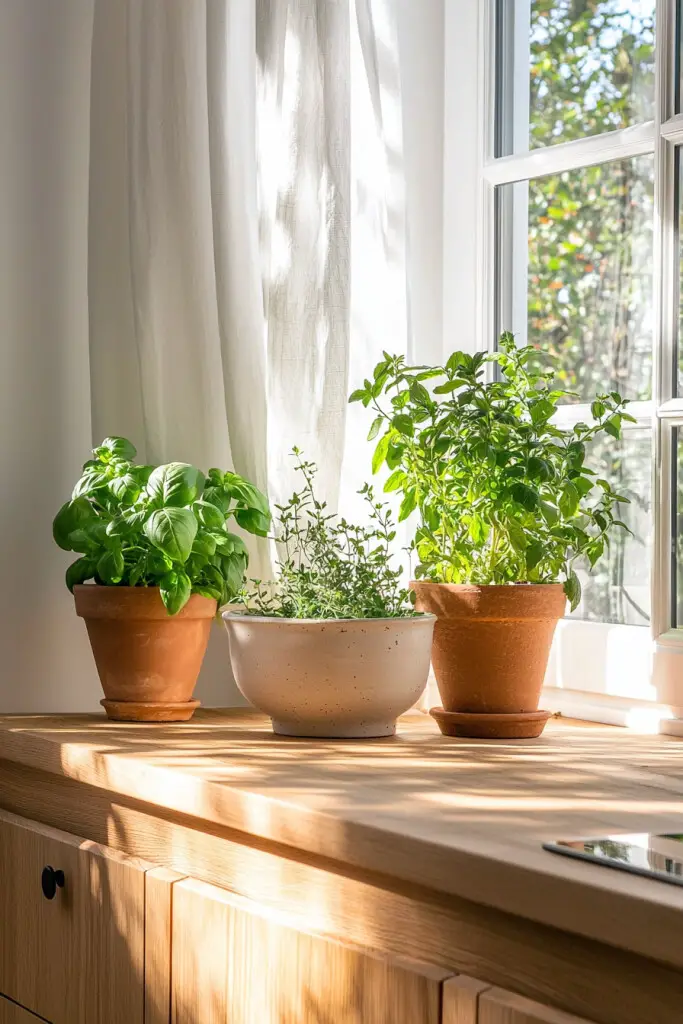
While you may not have a sprawling backyard, creating a herb garden in your kitchen can be an effortless way to bring a touch of nature indoors. Start by selecting a sunny windowsill or countertop that gets plenty of light.
You can use small pots or stylish containers that echo the wabi-sabi aesthetic, embracing imperfections and natural materials. Choose easy-to-grow herbs like basil, parsley, or mint, which not only add flavor to your meals but also offer delightful aromas.
Remember to water them regularly, allowing the soil to dry slightly between waterings. For added charm, consider labeling each pot with handwritten tags, giving your kitchen a personal touch.
This mini herb garden isn’t just functional; it’ll enhance your cooking experience and create a calming, organic vibe in your space. Enjoy the process, and watch your kitchen flourish with life!
13.Select Rustic Furniture
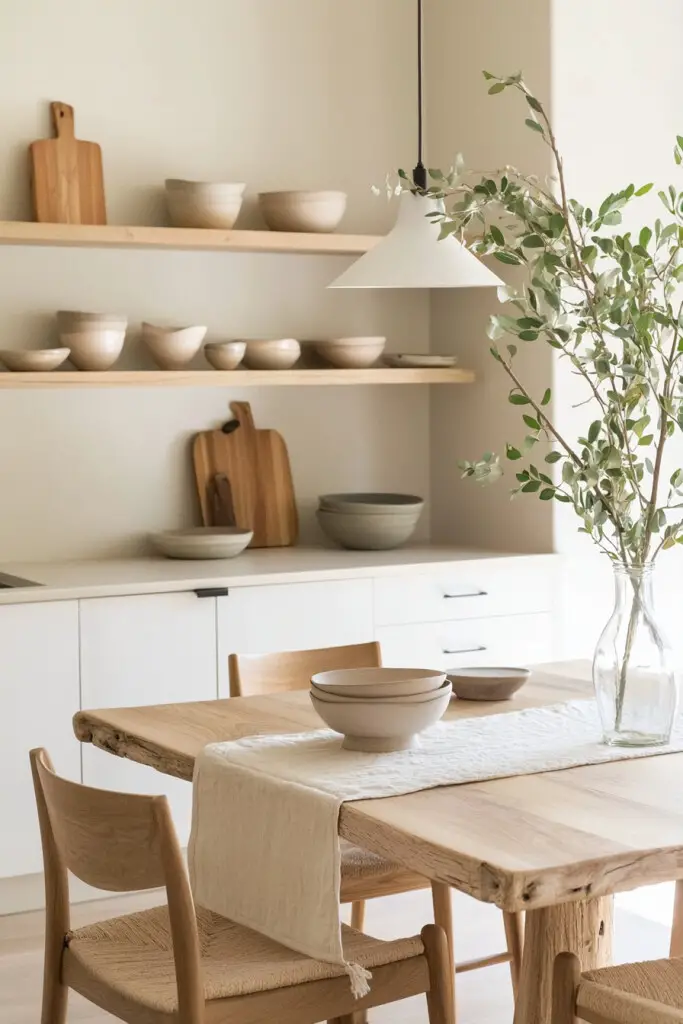
After you’ve infused your kitchen with the fresh scents of a herb garden, the next step in creating a harmonious wabi-sabi environment is selecting rustic furniture. Think about incorporating pieces that showcase natural materials like reclaimed wood or wrought iron.
These elements not only add warmth but also tell a story, reflecting the beauty of imperfection. Consider a sturdy farmhouse table with a distressed finish; it invites gatherings and shared meals.
Complement it with mismatched chairs, each with its own character, creating a cozy, lived-in feel. Don’t shy away from vintage cabinets or shelving units that reveal their age through charming wear and tear.
These rustic pieces provide functionality while enhancing the aesthetic of your kitchen. In essence, select furniture that resonates with your personal style, embodies simplicity, and embraces the authentic beauty found in nature and time. This thoughtful selection will complete your wabi-sabi kitchen beautifully.
14.Use Stone Accents
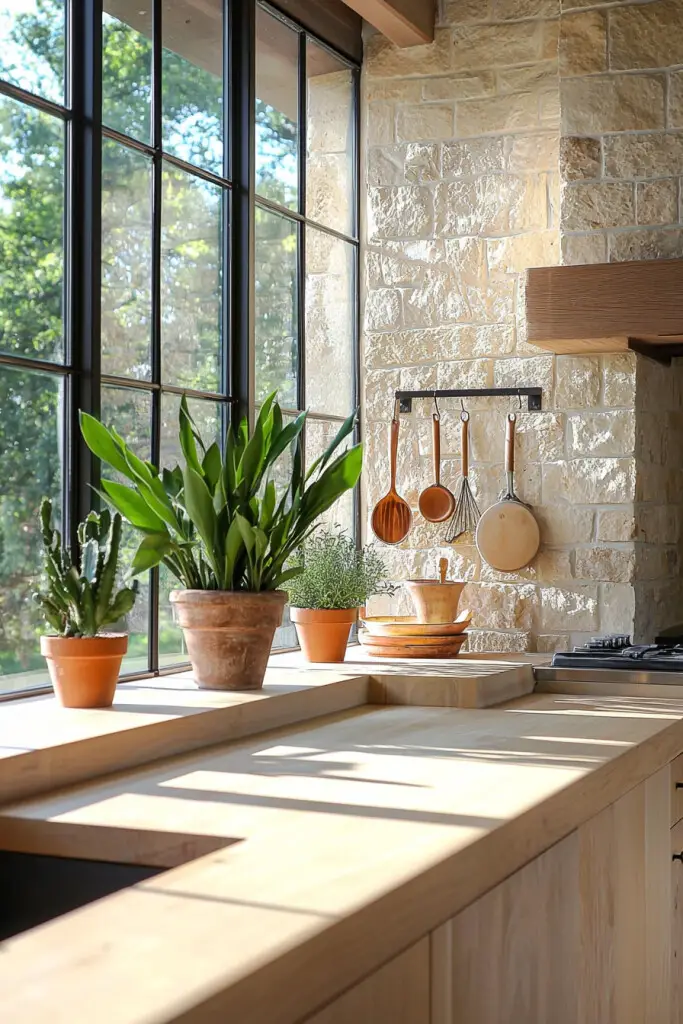
Incorporating stone accents can elevate your kitchen’s aesthetic, bringing a touch of nature indoors. Think about using materials like granite, marble, or slate for countertops or backsplashes.
These stones not only offer durability but also showcase unique textures and colors that add character to your space. You might consider a rough-hewn stone wall or a subtle pebble backsplash that draws the eye without overwhelming the design.
Additionally, stone can be introduced through smaller elements like a rustic stone sink or decorative stoneware. These features create a harmonious balance between functionality and beauty.
When selecting stone accents, aim for a weathered look—imperfections tell a story and align perfectly with the wabi-sabi philosophy of appreciating the beauty in the imperfect. By thoughtfully integrating stone into your kitchen, you’ll not only enhance its visual appeal but also create a warm, inviting atmosphere that feels naturally grounded.
15.Incorporate Plants and Greenery
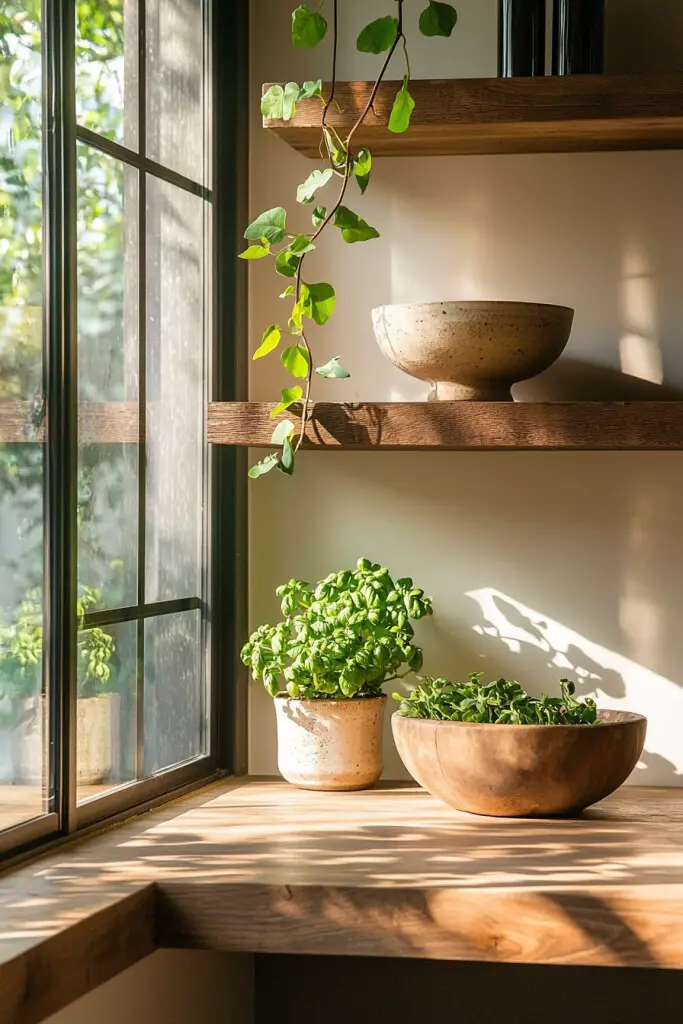
Adding plants and greenery can transform your kitchen into a vibrant, inviting space. Imagine the lush green leaves of potted herbs like basil and rosemary brightening your countertop, not just for aesthetics but also for culinary convenience.
You can hang trailing plants like pothos from shelves or place succulents on windowsills, creating a natural, organic touch that complements the Wabi Sabi philosophy of embracing imperfection. Consider using a mix of textures and colors—like the soft green of ferns paired with the deep hues of leafy greens.
Group your plants in varied heights for visual interest, and don’t hesitate to use rustic ceramic pots that echo the earthiness of your kitchen. Not only do plants purify the air, but they also foster a sense of tranquility, making your kitchen a more enjoyable place to gather and create. Incorporating greenery is a simple yet impactful way to enhance your space.
16.Design With Asymmetry in Mind
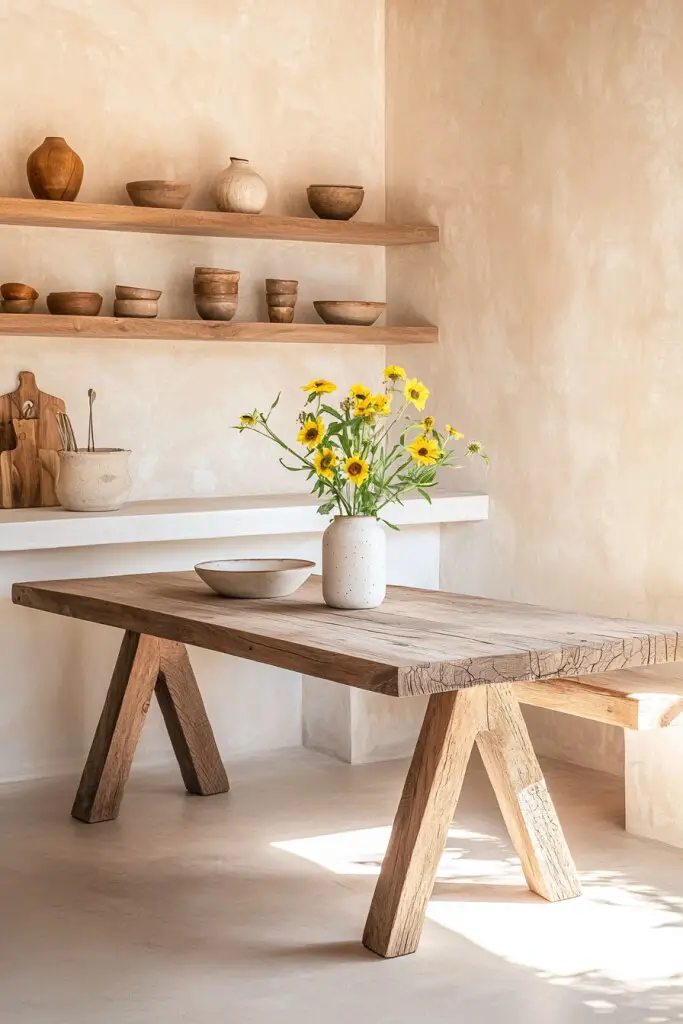
While many kitchens lean towards symmetrical layouts for a polished look, embracing asymmetry can add character and charm to your space. Think about mixing different heights and shapes in your cabinetry.
For instance, you could have open shelving on one side complemented by a traditional cabinet on the other. This playful contrast invites the eye to explore.
You can also incorporate unique, mismatched dining chairs around a rustic table, enhancing the casual, inviting vibe of your kitchen. Opt for varied textures and materials; a wooden countertop paired with a sleek metal island creates an intriguing balance.
Don’t shy away from displaying your favorite dishware or art pieces unevenly on shelves or countertops. These personal touches tell your story and create a lived-in feel. By designing with asymmetry in mind, you’ll create a kitchen that feels warm, inviting, and undeniably unique.
17.Choose a Minimalist Approach
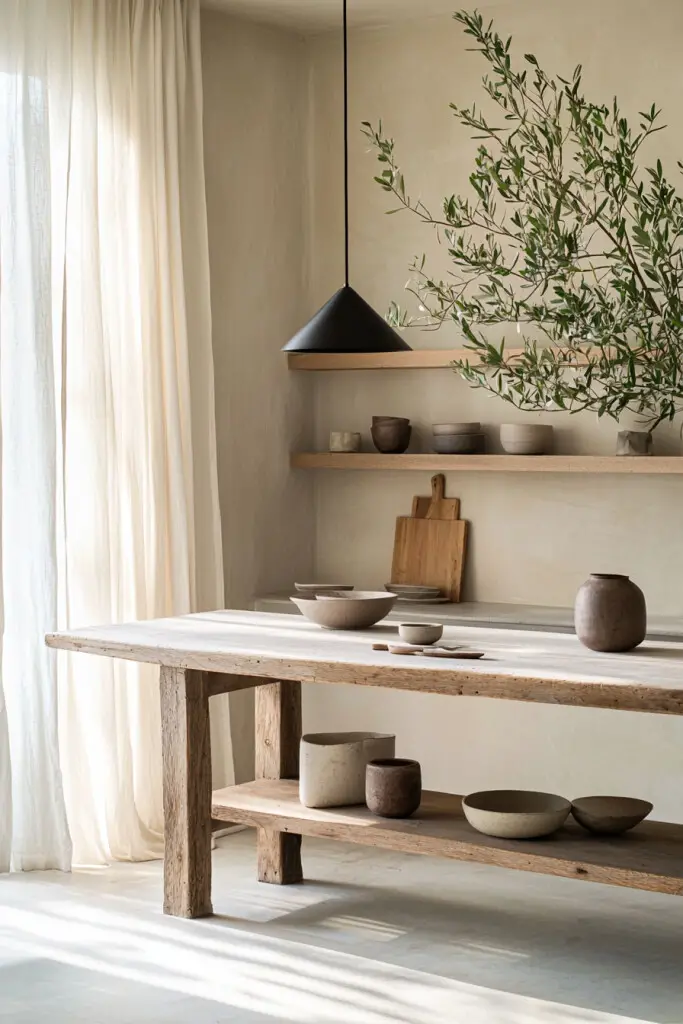
Choosing a minimalist approach can transform your kitchen into a serene retreat, where simplicity reigns and functionality shines. By decluttering your space, you’ll create an atmosphere that invites calm and focus.
Start by selecting essential items and letting go of anything that doesn’t serve a purpose or bring you joy. Opt for a neutral color palette to foster a peaceful vibe, and choose sleek, streamlined cabinetry that complements this aesthetic.
Use open shelving to display a few carefully chosen utensils or dishware, adding character without overwhelming the senses. Incorporate multifunctional furniture, like an island that serves as both a prep space and dining area, to enhance practicality.
Remember, it’s about embracing the beauty of imperfection, so don’t shy away from natural materials that exhibit character and warmth. With a minimalist mindset, your kitchen can become a harmonious blend of form and function.
18.Utilize Raw Edge Surfaces
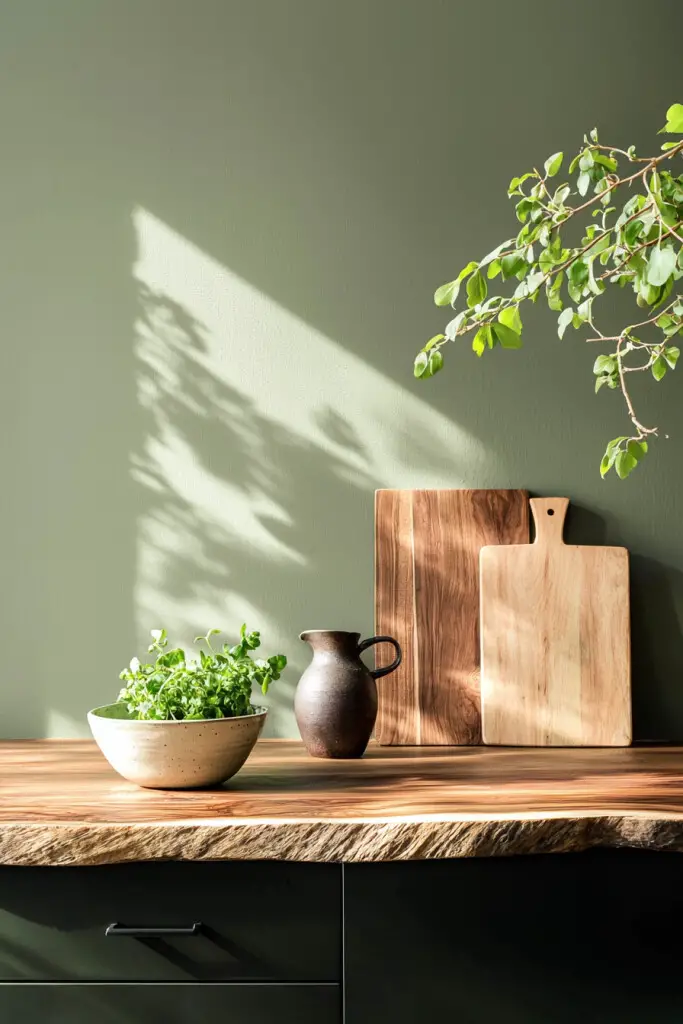
To enhance the minimalist vibe of your kitchen, consider incorporating raw edge surfaces that celebrate the beauty of nature. These surfaces, often made from natural wood or stone, showcase organic lines and textures, bringing a rustic charm to your space.
Imagine a kitchen island crafted from a slab of live-edge wood, where the bark remains intact, creating a stunning focal point. Using raw edges not only adds character but also connects your kitchen to the outdoors.
Pair these surfaces with simple cabinetry and neutral colors to maintain a balanced aesthetic. You can also mix raw edge countertops with sleek metal or glass for a striking contrast.
Don’t shy away from imperfections; they tell a story and evoke a sense of warmth. By embracing raw edge surfaces, you’ll cultivate a kitchen that’s both functional and visually appealing, embodying the essence of Wabi Sabi with every meal you create.
19.Add Personal Touches With Art
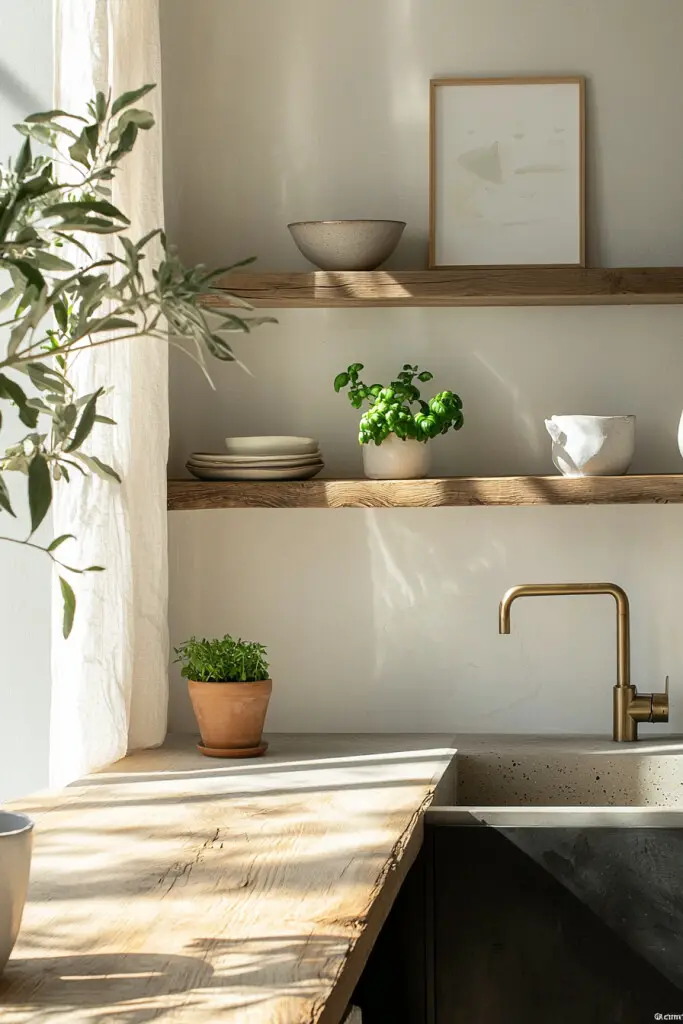
How can you transform your kitchen into a personal sanctuary? One of the simplest ways is to infuse it with art that speaks to you. Think about hanging a collection of your favorite prints or photographs that evoke cherished memories.
You might even consider displaying handmade pottery or rustic wooden pieces that reflect the beauty of imperfection, a key element of wabi-sabi philosophy. Don’t shy away from mixing styles—vintage frames paired with contemporary artwork can create a delightful contrast. You can also incorporate functional art, like a beautifully crafted cutting board or an eye-catching wall clock.
20.Prioritize Natural Light
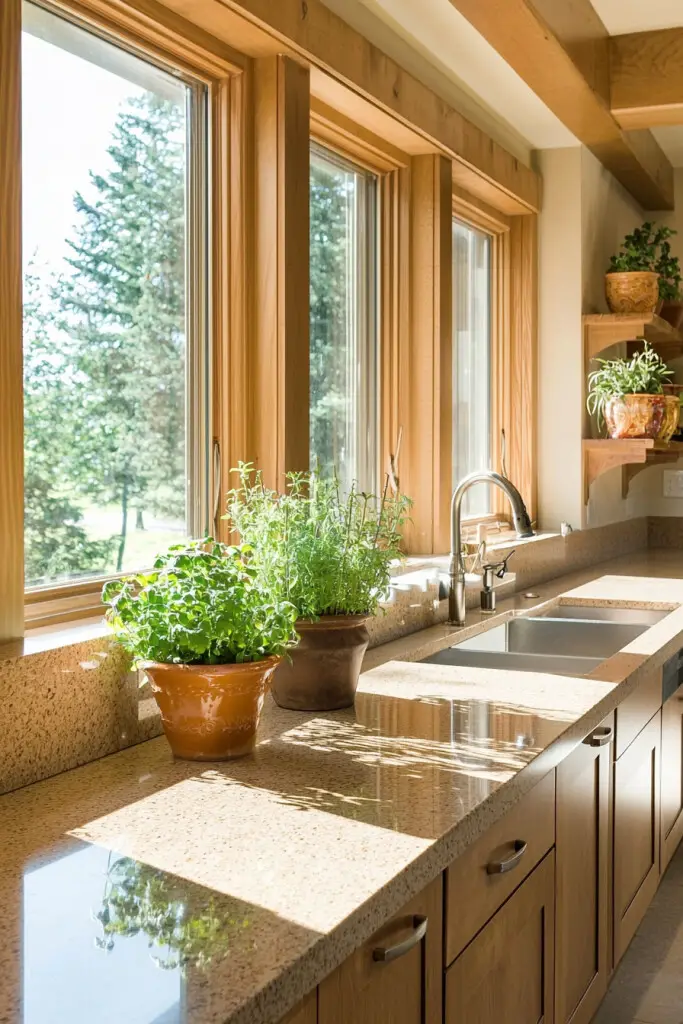
While you might not realize it, natural light can considerably enhance the ambiance of your kitchen, making it feel more open and inviting. Large windows are a fantastic way to invite this light in, flooding your space with warmth.
If you’re lucky enough to have a window over your sink, you’ll enjoy a lovely view while washing dishes, and the sunlight will uplift your spirits. To maximize this effect, consider using light-colored walls or reflective surfaces like glass or polished wood.
These elements bounce light around, creating a brighter environment. You might also want to think about sheer curtains that allow light to filter through without sacrificing privacy.
Incorporating skylights or sun tunnels can also be a game-changer, especially in smaller kitchens that need a boost. By prioritizing natural light, you’re not only enhancing the aesthetics but also creating a more functional and enjoyable cooking space.
21.Incorporate Vintage Fixtures
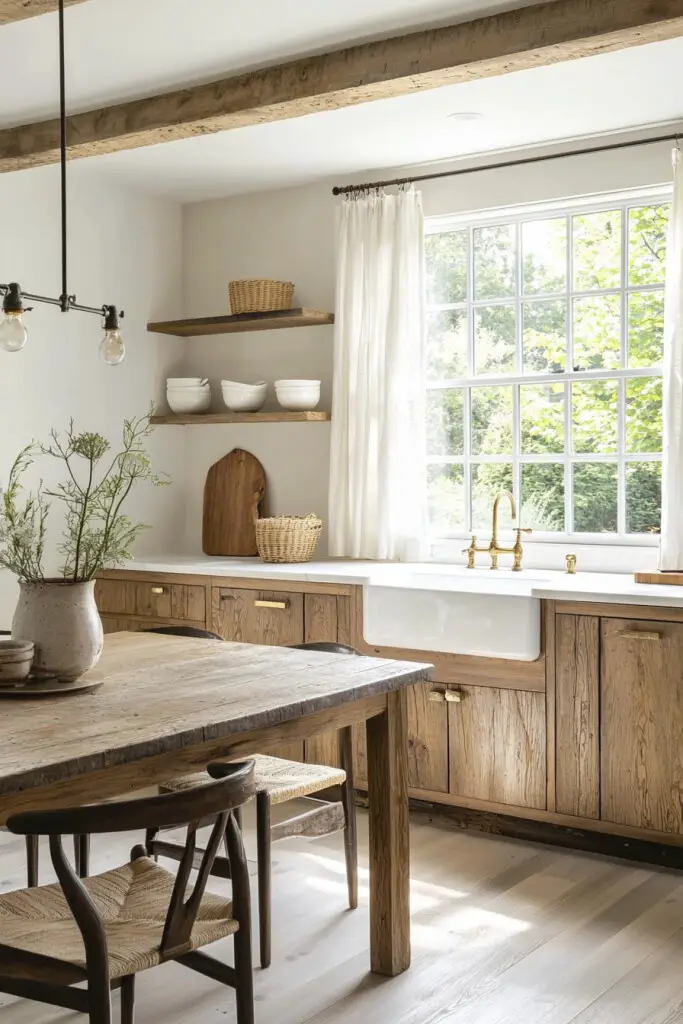
There’s something undeniably charming about incorporating vintage fixtures into your kitchen design. These pieces can serve as focal points that evoke nostalgia while blending seamlessly with Wabi Sabi principles.
Think about adding a rustic farmhouse sink or a classic chandelier; these fixtures bring warmth and character to your space. You can also search for antique knobs and pulls that add a unique touch to your cabinetry.
These small details can transform the ordinary into the extraordinary, showcasing your personality and style. Consider vintage lighting as well.
A retro pendant light can cast a beautiful glow, creating an inviting atmosphere for family and friends. Don’t shy away from mixing different eras—this eclectic approach can enhance the visual interest in your kitchen.
22.Use Soft, Flowing Fabrics
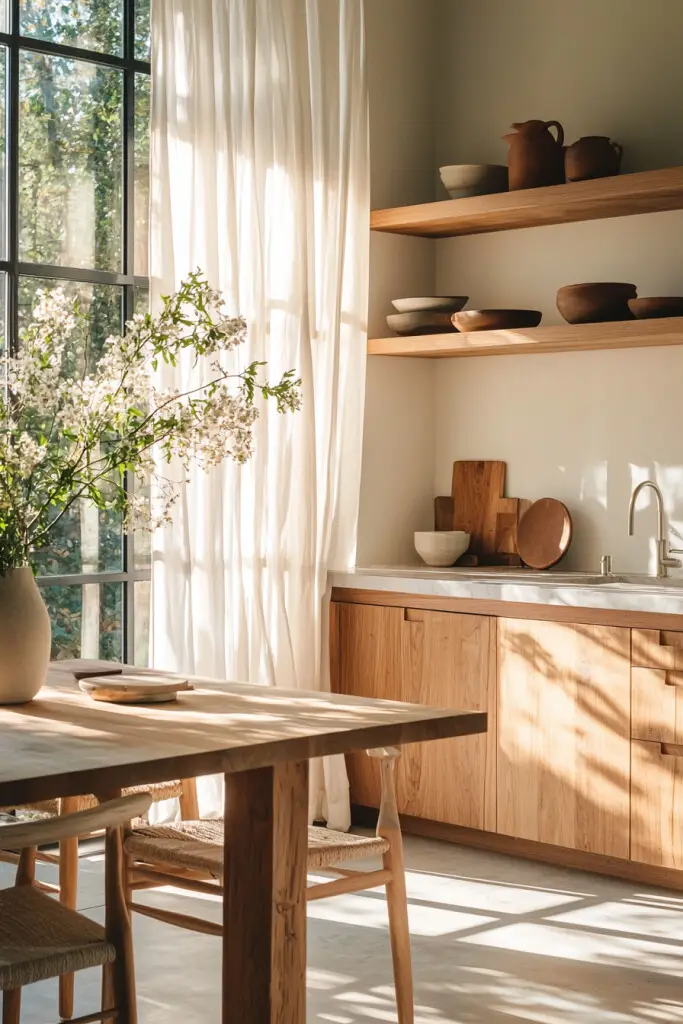
To create a warm and inviting atmosphere in your Wabi Sabi kitchen, using soft, flowing fabrics can make a significant difference. Think about incorporating linen or cotton curtains that gently filter sunlight, casting a serene glow throughout the space.
These materials not only add a touch of elegance but also promote a sense of calm and comfort. You can also consider tablecloths and runners in muted, earthy tones, enhancing the organic feel of your kitchen.
Choose fabrics with subtle textures or patterns that evoke a sense of nature without overwhelming the senses. Don’t forget about kitchen textiles like dish towels and aprons; opt for soft, durable fabrics that contribute to the overall aesthetic while being practical.
By weaving in these elements, you’ll cultivate a harmonious environment that embraces imperfection and celebrates the beauty of simplicity. Embrace the flow of these fabrics to truly elevate your Wabi Sabi kitchen experience.
23.Combine Old and New Elements
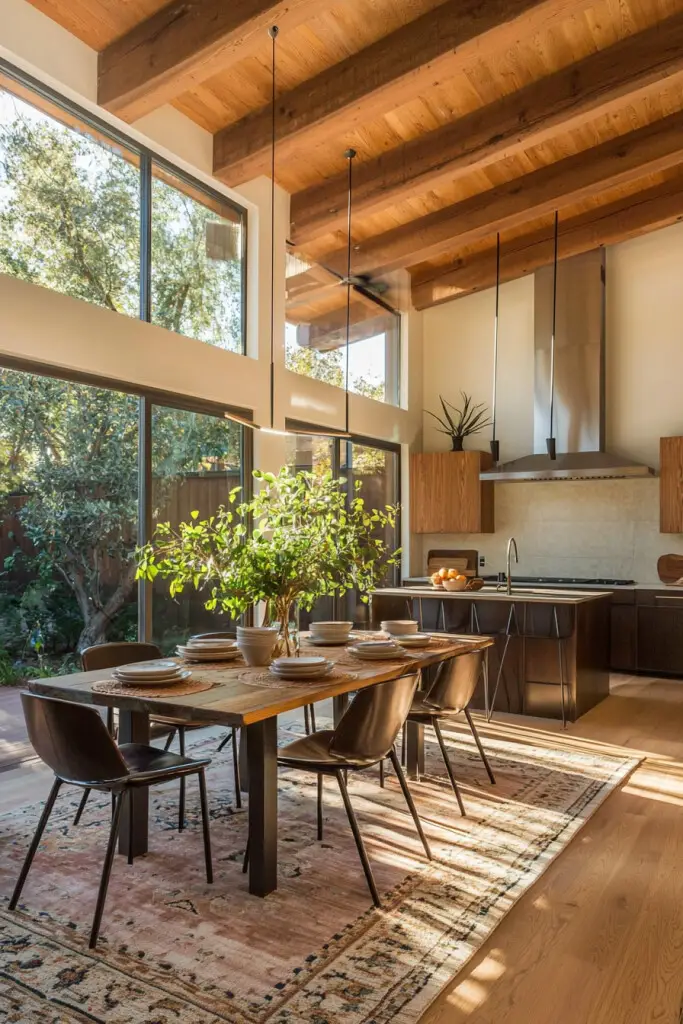
Incorporating soft, flowing fabrics sets a cozy tone in your Wabi Sabi kitchen, but the true charm lies in blending old and new elements. Imagine a reclaimed wooden table paired with sleek, modern chairs—this contrast adds depth and character.
You can showcase vintage dishware on open shelving while utilizing contemporary appliances, creating a harmonious balance between past and present. Consider adding a rustic, hand-crafted cutting board next to a minimalist knife set; the interplay of textures tells a story.
Accent your space with antique glass jars alongside stylish, new cookware. This combination not only honors the beauty of imperfection but also fosters a sense of history.
24.Create Cozy Nooks
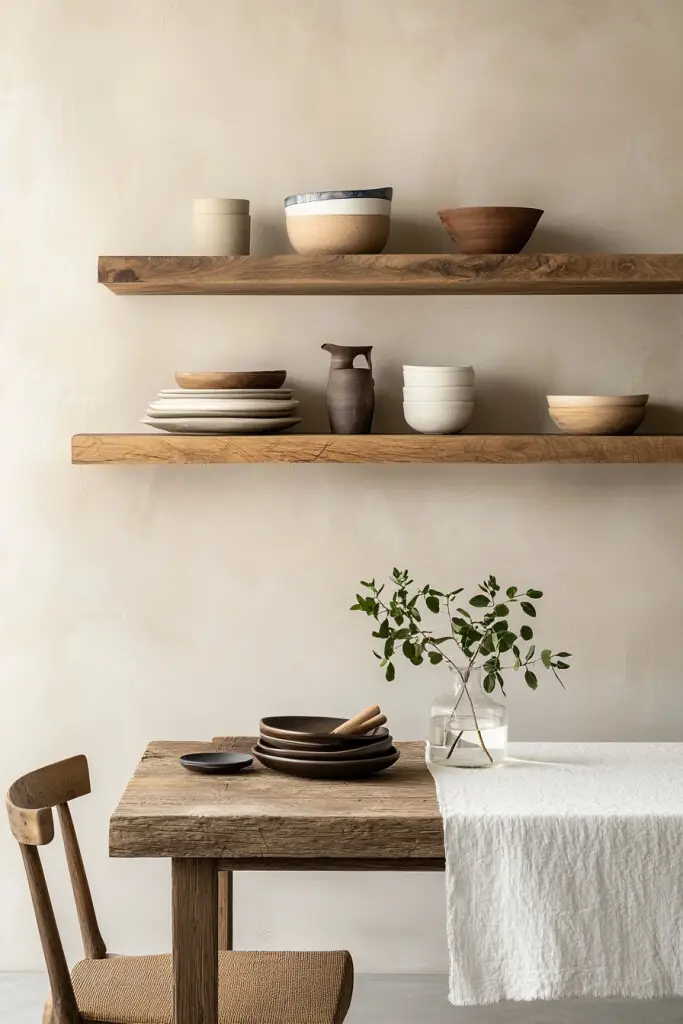
While your Wabi Sabi kitchen may be functional, creating cozy nooks can transform it into a welcoming retreat. Think about using a corner of your kitchen for a small bistro table paired with mismatched chairs.
This intimate setup invites you to enjoy a morning coffee or a quiet evening snack. Layer soft textiles, like a worn tablecloth or plush cushions, to enhance comfort and warmth.
You might also consider a reading nook by a window, adorned with a vintage armchair and a small bookshelf filled with your favorite cookbooks. Surround it with plants for a touch of nature, further enhancing the tranquil vibe.
25.Celebrate the Beauty of Wear and Tear
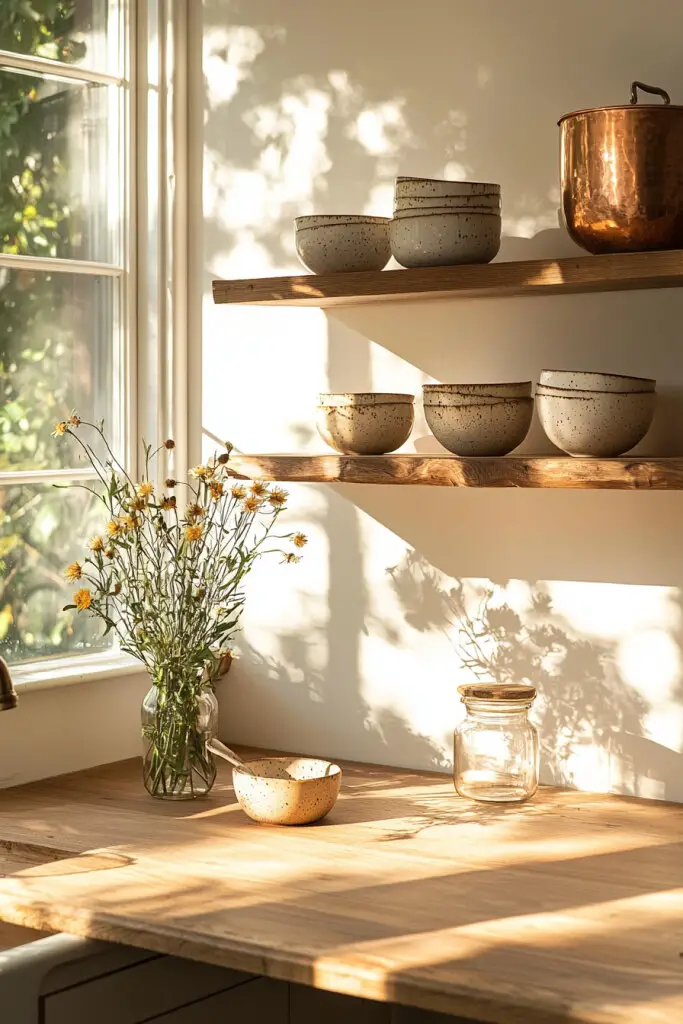
Embracing the imperfections of your kitchen can create a space that tells a story. Each scratch on the countertop and every worn-out cabinet handle adds character and warmth, reminding you of countless meals shared and memories made.
Rather than hiding these signs of use, celebrate them. Choose reclaimed wood for shelves or a table that shows its age; their unique textures will enhance your kitchen’s charm.
You might even consider open shelving to display mismatched dishes, showcasing their history and individuality. Incorporating vintage appliances or cookware can further highlight the beauty of wear and tear, blending functionality with nostalgia.
Add elements like handmade pottery or artisanal textiles to soften the look, creating a balanced aesthetic. Ultimately, your kitchen becomes a reflection of life’s journey—imperfect yet beautiful, inviting yet practical, where every blemish is a badge of honor in your culinary adventures.
Conclusion
Embracing wabi-sabi in your kitchen invites a sense of warmth and authenticity into your home. By blending natural materials, earthy colors, and vintage pieces, you can create a space that’s not just functional but also beautifully imperfect.
Each element tells a story, celebrating the charm of wear and tear. So go ahead, infuse your kitchen with these ideas, and transform it into a cozy sanctuary that reflects your unique style and appreciation for life’s fleeting beauty.
